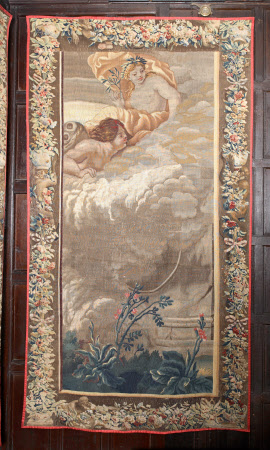Zephyr
Flemish
Category
Tapestries
Date
circa 1660 - circa 1680
Materials
Tapestry, wool and silk, 7-8 warps per cm
Measurements
2.38 m (H); 1.33 m (W)
Place of origin
Belgium
Order this imageCollection
Speke Hall, Merseyside
NT 1197390.2
Summary
Tapestry, wool and silk, 7-8 warps per cm, Zephyr from a set of three of the Story of Psyche, Flemish, c. 1660-1680. The design is dominated by a large brownish cloud with two figures floating at the top left and part of a stone plinth or building at the lower right, with some plants growing in the foreground. One of the figures is a young man who leans forward and purses his lips to blow, and the other is a young woman wearing a laurel wreath and holding an olive branch. The tapestry has borders of flowers, ribbons, pots and monkeys on a dark brown ground, but these have been sewn on and are probably not all original to the main scene, as parts of them have a higher warp count.
Full description
The exact scene represented is not clear, and the tapestry must be part of a larger piece. The young man in the clouds at the upper left represents the god of the west wind, Zephyr, who is usually represented blowing with his lips pursed and cheeks puffed out, as here. It was Zephyr who took Psyche away from her parents’ house and left her near Cupid’s palace. Later Zephyr brought Psyche’s sisters to visit her, and when they became jealous of her they tried to give themselves up to Zephyr by falling off a high crag into his arms, but they were abandoned and fell to their deaths. The story of Psyche is told in its fullest form in Apuleius’s 2nd-century novel ‘The Golden Ass’. Psyche was the youngest and most beautiful of three daughters of a king and queen, so beautiful that it was rumoured that she was the new Venus, and people began to worship her like a goddess. Although her two older sisters married, Psyche did not find love and her parents, eager to find her a husband, consulted an oracle of Apollo. They then offered her up to Zephyr, the god of the west wind, who took her and deposited her in a verdant meadow. Exploring, she finally found herself in a beautiful palace. Here she lived in great luxury and was visited each night by a man who made her his wife, but who never revealed his identity and forbade her to look upon him. One night, spurred on by her jealous sisters, Psyche lit a lamp and saw Cupid’s true form; but she accidentally spilled wax on him and woke him, causing him to flee. Psyche then wandered the earth looking for her lost lover, before being taken in by Venus. She was eventually accepted by Cupid as his wife and made immortal. All three of the tapestries at Speke Hall include elements recognisable from Psyche’s story, although the exact narrative of two of them is difficult to determine. All three tapestries seem to have been cut down from larger pieces, and all their borders have been sewn on, some of them from unrelated tapestries. The three must form part of a larger series of the Story of Psyche. A tapestry of ‘Zephyr Carrying Psyche Away’ which was bought by the New York dealers French and Company in 1961 may come from the same series as the tapestries at Speke, as the style of the figures and landscape are similar (Getty Photo Archive no. 0238950). A number of famous tapestry series of the ‘Story of Psyche’ were made during the sixteenth and seventeenth centuries. These include a now lost 26-piece set partly based on engravings by the Master of the Die, that was purchased by François I of France in c. 1540, and later copied in French seventeenth-century workshops; a set of six designed by Giovanni Battista Castello and woven in Brussels between 1562 and 1578; a series designed by Jan van Orley in c. 1685 and woven in Brussels; and a series produced at Aubusson from the 1660s onwards (Fenaille 1903-23, vol. I, pp 287-93; Clifford 1975; Reyniès 1995). The tapestries at Speke do not belong to any of these well-known series. They were probably woven at one of the Flemish weaving centres in the second half of the seventeenth century. It has previously been suggested that the tapestries were made at Mortlake, but this can be ruled out on stylistic grounds. Three fragments now kept in storage at Speke (no. 1197407) are clearly related to the Psyche tapestries but are themselves composed of unrelated fragments, confirming that the set has been altered more than once. (Helen Wyld, 2013)
Provenance
Miss Adeleide Watt (1857-1921); Trustees of the late Miss Adeleide Watt, 1921-1942; National Trust from 1943
Makers and roles
Flemish, workshop
References
Clifford, 1975: Timothy Clifford, 'G.B. Castello's designs for the 'Cupid and Psyche' tapestries’, Burlington Magazine, April 1975, pp. 234-238 Reyniès 1995: Nicole de Reniès, ‘Jean van Orley: Une Tenture de l’Histoire de Psyché’, Gazette des Beaux-Arts, 6th series, no. 125 (March 1995), pp. 209-20 Fenaille, 1903-1923: Maurice Fenaille, État général des tapisseries de la Manufacture des Gobelins depuis son origine jusqu’à nos jours, 1600-1900, 4 vols., Paris, 1903-1923
